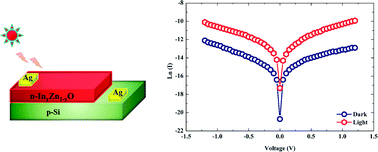Optoelectronic characteristics of chemically processed ultra-thin InyZn1−yO nanostructures†
Abstract
InyZn1−yO nanostructures were processed through a solution-based strategy for optoelectronic-related functions. Their crystalline structure, phase purity and valence states of various transition metal ions existing within them were studied in detail using X-ray diffraction, Raman and X-ray photoelectron spectroscopic measurements. The morphological dimension of the nanostructures was observed to be of sheet-like form from the electron microscopic results, while the optical band gap was estimated to be around 3.13 eV using Tauc's plot. The luminescence measurements revealed the nanosheets to be associated with multiple defects through the wide sub-band edge emissions in the visible region. The origin of defect-related emission was also substantiated using Raman spectroscopy. The electrical properties of the nanosheets were studied from the Nyquist and Mott–Schottky plots, which were established through electrochemical impedance spectroscopic measurements. The optoelectronic capabilities of InyZn1−yO were investigated via establishing p–n architectures using silicon (p-Si) and studying their corresponding current–voltage (I–V) characteristics. UV photon irradiation was found to substantiate the potential of the fabricated heterostructures for optoelectronic functions.


 Please wait while we load your content...
Please wait while we load your content...